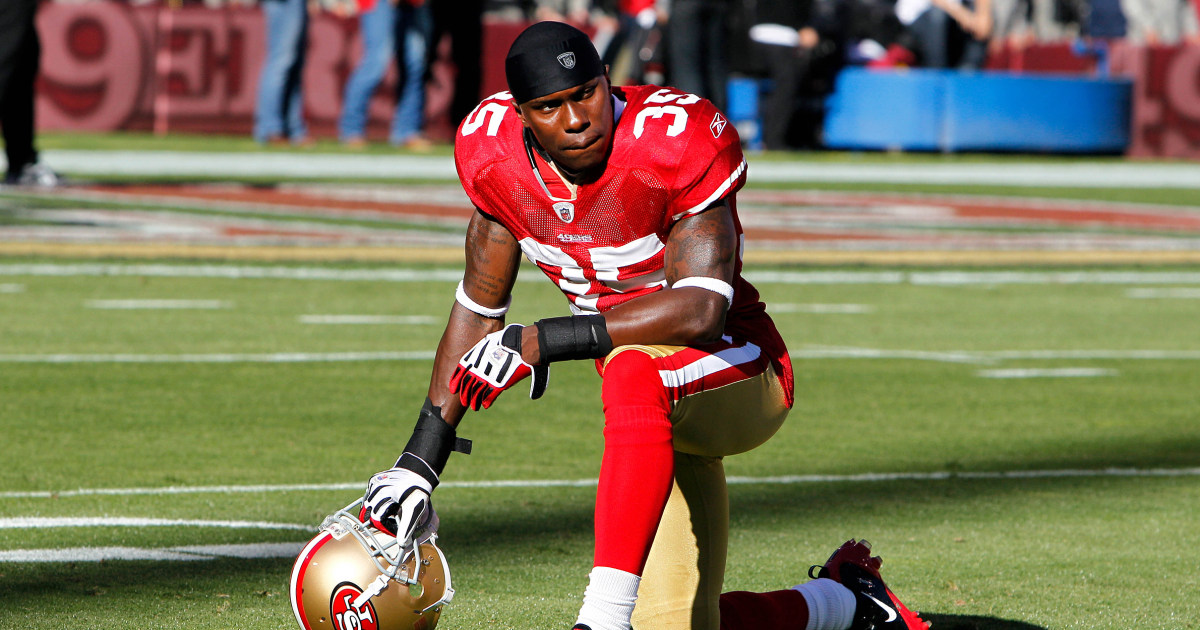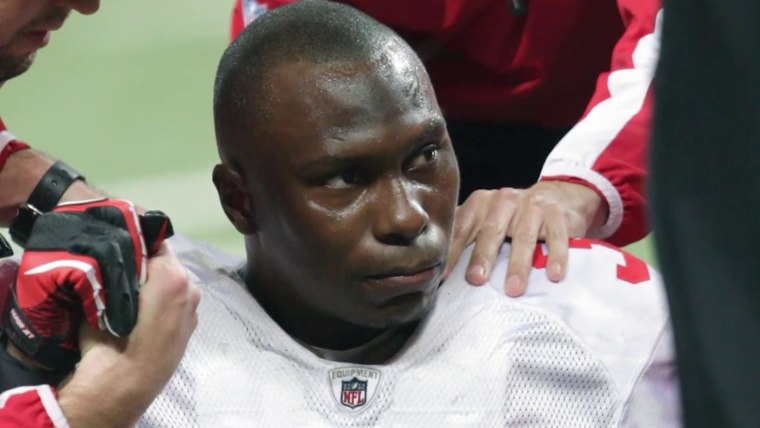Former NFL player Phillip Adams had stage 2 chronic traumatic encephalopathy, or CTE, when he allegedly gunned down six people before taking his own life in April in South Carolina, officials announced Tuesday.
Boston University’s Dr. Ann McKee, who conducted the examination on Adams' brain tissue, said in a news conference Tuesday that Adams' CTE was “unusually severe in both frontal lobes" and may have contributed to his “behavioral abnormalities.”
CTE is a degenerative brain disease caused by repeated head traumas that can only be diagnosed after death, according to the Mayo Clinic.
CTE has been found in the brains of people who have played football and other contact sports and possible symptoms include cognitive, behavioral and mood changes.
Adams, 32, had suffered multiple injuries during his six-year NFL career, and his father, Alonzo Adams, told NBC affiliate WCNC at the time of the shooting that “I think the football messed him up.”
The attacked occurred in Rock Hill on April 7.
Ex-NFL player Phillip Adams kills five people, then himself
April 8, 202105:23Adams allegedly shot Dr. Robert Lesslie, 70; his wife Barbara Lesslie, 69; and two of their grandchildren, Adah, 9, and Noah, 5, police said. He also shot two air conditioning technicians, James Lewis, 38, and Robert Shook, 38, according to authorities.
Adams later died by suicide. He was found dead from a suspected self-inflicted gunshot wound in a nearby home on the same street as the victims, officials said.
After the incident, York County Coroner Sabrina Gast obtained special permission to have Phillip’s brain tissue sent in for CTE tests in collaboration with Boston University researchers, who have been at the forefront of studying the brain disease.
"Adams' 20-year career in football put him at a high risk for CTE," McKee said Thursday.
She noted that the disease worsens with age, citing that Boston University's CTE center has diagnosed the brain disease in 24 NFL players who died in their 20s and 30s — with most found to suffer stage 2 CTE.
Stage 2 CTE is associated with progressive cognitive and behavioral abnormalities such as aggression, depression, paranoia, anxiety, poor executive function and memory loss, McKee said.
Adams' severe CTE pathology was similar to that of former NFL player Aaron Hernandez, McKee said. Hernandez was convicted of murder in 2015 and died by suicide two years later. He was posthumously diagnosed with CTE.
At the news conference, a statement on behalf of the Adams family was read.
"As we process these results we are deeply saddened by the events that occurred on April 7 and we continue to pray for the families of the victims. We are pleased to have a better understanding of the mental turmoil that Phillip was dealing with during the last moments of his life. We cannot say that we are surprised by these results. However it is shocking to hear how severe his condition was."
"After going through medical records through his football career, we do know that he was desperately seeking help from the NFL, but was denied all claims due to his inability to remember things and to handle seemingly simple tasks, such as traveling hours away to see doctors and going through extensive evaluations."
"We hope to bring awareness to this condition so players young and old can understand the risks ... Phillip is not the first to battle with this disease and he will not be the last."
Adams, originally from Rock Hill, played with the San Francisco 49ers, the New England Patriots, the Seattle Seahawks, the Oakland Raiders, the New York Jets and most recently the Atlanta Falcons until 2015.
He suffered a gruesome injury during a game Dec. 26, 2010, in his rookie season, between his visiting 49ers and the St. Louis Rams. In that game, his left ankle and foot appeared to be snapped and pointed in different directions after he was pinned down by a Rams player.
He also suffered two concussions in the 2012 season with the Raiders.
Investigators have not disclosed a motive for the shooting.
‘I think football messed him up’: Former NFL player’s father speaks out after son allegedly kills five people
April 8, 202101:21York County officials said Thursday authorities don’t know why Adams targeted the Lesslie home and family. The only connection is that they lived in proximity to one another.
Sheriff Kevin Tolson said a conclusion in the investigation should be coming soon, noting that they’ve handed over “incoherent writings” found during a search of Adams’ home to the FBI.
“Sometimes the why is obvious, what we have here is a big puzzle,” Tolson said. "There’s one individual who knows the why and he is deceased. We may not know in this life."
If you or someone you know is at risk of suicide, please call the National Suicide Prevention Lifeline at 800-273-8255, text TALK to 741741 or visit SpeakingOfSuicide.com/resources for additional resources.
Former NFL player Phillip Adams had stage 2 chronic traumatic encephalopathy, or CTE, when he allegedly gunned down six people before taking his own life in April in South Carolina, officials announced Tuesday.
Boston University’s Dr. Ann McKee, who conducted the examination on Adams' brain tissue, said in a news conference Tuesday that Adams' CTE was “unusually severe in both frontal lobes" and may have contributed to his “behavioral abnormalities.”
CTE is a degenerative brain disease caused by repeated head traumas that can only be diagnosed after death, according to the Mayo Clinic.
CTE has been found in the brains of people who have played football and other contact sports and possible symptoms include cognitive, behavioral and mood changes.
Adams, 32, had suffered multiple injuries during his six-year NFL career, and his father, Alonzo Adams, told NBC affiliate WCNC at the time of the shooting that “I think the football messed him up.”
The attacked occurred in Rock Hill on April 7.
Ex-NFL player Phillip Adams kills five people, then himself
April 8, 202105:23Adams allegedly shot Dr. Robert Lesslie, 70; his wife Barbara Lesslie, 69; and two of their grandchildren, Adah, 9, and Noah, 5, police said. He also shot two air conditioning technicians, James Lewis, 38, and Robert Shook, 38, according to authorities.
Adams later died by suicide. He was found dead from a suspected self-inflicted gunshot wound in a nearby home on the same street as the victims, officials said.
After the incident, York County Coroner Sabrina Gast obtained special permission to have Phillip’s brain tissue sent in for CTE tests in collaboration with Boston University researchers, who have been at the forefront of studying the brain disease.
"Adams' 20-year career in football put him at a high risk for CTE," McKee said Thursday.
She noted that the disease worsens with age, citing that Boston University's CTE center has diagnosed the brain disease in 24 NFL players who died in their 20s and 30s — with most found to suffer stage 2 CTE.
Stage 2 CTE is associated with progressive cognitive and behavioral abnormalities such as aggression, depression, paranoia, anxiety, poor executive function and memory loss, McKee said.
Adams' severe CTE pathology was similar to that of former NFL player Aaron Hernandez, McKee said. Hernandez was convicted of murder in 2015 and died by suicide two years later. He was posthumously diagnosed with CTE.
At the news conference, a statement on behalf of the Adams family was read.
"As we process these results we are deeply saddened by the events that occurred on April 7 and we continue to pray for the families of the victims. We are pleased to have a better understanding of the mental turmoil that Phillip was dealing with during the last moments of his life. We cannot say that we are surprised by these results. However it is shocking to hear how severe his condition was."
"After going through medical records through his football career, we do know that he was desperately seeking help from the NFL, but was denied all claims due to his inability to remember things and to handle seemingly simple tasks, such as traveling hours away to see doctors and going through extensive evaluations."
"We hope to bring awareness to this condition so players young and old can understand the risks ... Phillip is not the first to battle with this disease and he will not be the last."
Adams, originally from Rock Hill, played with the San Francisco 49ers, the New England Patriots, the Seattle Seahawks, the Oakland Raiders, the New York Jets and most recently the Atlanta Falcons until 2015.
He suffered a gruesome injury during a game Dec. 26, 2010, in his rookie season, between his visiting 49ers and the St. Louis Rams. In that game, his left ankle and foot appeared to be snapped and pointed in different directions after he was pinned down by a Rams player.
He also suffered two concussions in the 2012 season with the Raiders.
Investigators have not disclosed a motive for the shooting.
‘I think football messed him up’: Former NFL player’s father speaks out after son allegedly kills five people
April 8, 202101:21York County officials said Thursday authorities don’t know why Adams targeted the Lesslie home and family. The only connection is that they lived in proximity to one another.
Sheriff Kevin Tolson said a conclusion in the investigation should be coming soon, noting that they’ve handed over “incoherent writings” found during a search of Adams’ home to the FBI.
“Sometimes the why is obvious, what we have here is a big puzzle,” Tolson said. "There’s one individual who knows the why and he is deceased. We may not know in this life."
If you or someone you know is at risk of suicide, please call the National Suicide Prevention Lifeline at 800-273-8255, text TALK to 741741 or visit SpeakingOfSuicide.com/resources for additional resources.



